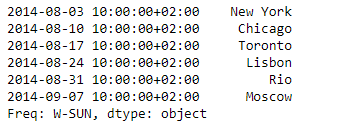Python | Pandas Series.to_sparse()
Last Updated :
05 Feb, 2019
Pandas series is a One-dimensional ndarray with axis labels. The labels need not be unique but must be a hashable type. The object supports both integer- and label-based indexing and provides a host of methods for performing operations involving the index.
Pandas Series.to_sparse() function convert the given Series object to SparseSeries. Sparse objects are basically compressed objects. If some of the data in our Series object is missing then, those locations will be Sparsified. Memory won’t be wasted in storing missing values.
Syntax: Series.to_sparse(kind=’block’, fill_value=None)
Parameter :
kind : {‘block’, ‘integer’}
fill_value : float, defaults to NaN (missing)
Returns : sp : SparseSeries
Example #1: Use Series.to_sparse() function to convert the given series object to SparseSeries object.
import pandas as pd
sr = pd.Series(['New York', 'Chicago', 'Toronto', 'Lisbon', 'Rio', 'Moscow'])
didx = pd.DatetimeIndex(start ='2014-08-01 10:00', freq ='W',
periods = 6, tz = 'Europe/Berlin')
sr.index = didx
print(sr)
|
Output :

Now we will use Series.to_sparse() function to achieve the conversion of the given Series object to SparseSeries object.
Output :

As we can see in the output, the Series.to_sparse() function has successfully converted the given series object to sparseseries object.
Example #2: Use Series.to_sparse() function to convert the given series object to SparseSeries object.
import pandas as pd
sr = pd.Series([19.5, 16.8, None, 22.78, None, 20.124, None, 18.1002, None])
print(sr)
|
Output :

Now we will use Series.to_sparse() function to achieve the conversion of the given Series object to SparseSeries object.
Output :

As we can see in the output, the Series.to_sparse() function has successfully converted the given series object to sparseseries object. If we look at the bottom two lines, it has returned the info about memory Block location and the number of values contained in those blocks.
Like Article
Suggest improvement
Share your thoughts in the comments
Please Login to comment...